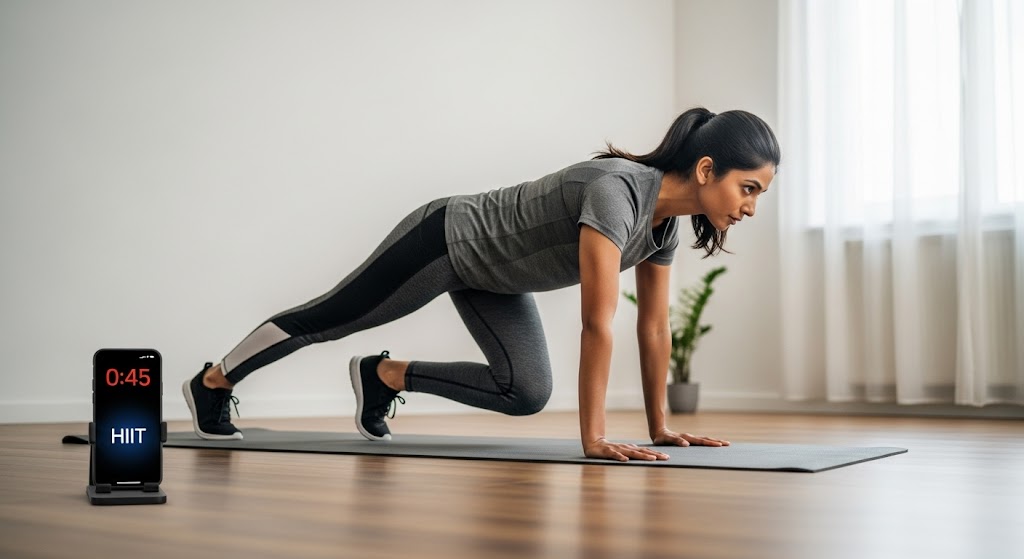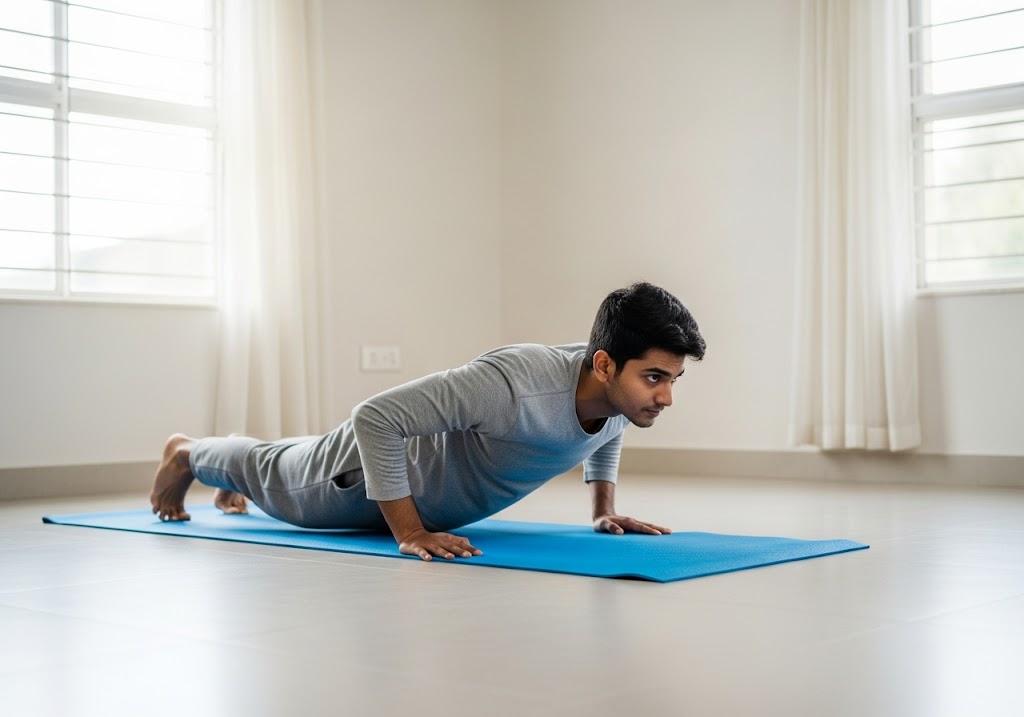Will HIIT burn fat effectively for weight loss? Yes, HIIT burns fat effectively by increasing metabolism during and after exercise, with studies showing 0.13g additional fat burned per minute of activity after 12 weeks.
High-Intensity Interval Training has become one of the most popular workout methods for people wanting to lose fat quickly. Many fitness enthusiasts ask will HIIT burn fat better than traditional cardio exercises. The answer lies in scientific research that shows HIIT creates powerful metabolic changes in your body.
When you perform HIIT workouts, you alternate between short bursts of intense exercise and recovery periods. This training method triggers unique fat-burning processes that continue working long after your workout ends. Understanding how will HIIT burn fat helps you make better decisions about your fitness routine. Explore the science-backed insights in Can HIIT Build Muscle and discover how high‑intensity workouts can stimulate strength gains-with some important limitations
Table of Contents
Understanding HIIT and Fat Burning
HIIT workouts create powerful metabolic changes that directly answer the question will HIIT burn fat effectively. During high-intensity intervals, your body rapidly depletes energy stores and switches to fat as fuel. This process continues during recovery periods and extends well beyond your workout session.
The fat-burning power of HIIT comes from its ability to elevate your heart rate to 80-100% of maximum capacity. At these intensities, your body cannot rely solely on easily available energy sources. Instead, it must access fat stores to meet the increased energy demands, which explains why will HIIT burn fat so efficiently.
| HIIT Fat Burning Factor | Mechanism | Duration |
|---|---|---|
| Exercise Fat Oxidation | Direct fat burning during workout | 15-30 minutes |
| EPOC (Afterburn Effect) | Continued fat burning post-exercise | 24-48 hours |
| Metabolic Boost | Increased daily fat oxidation | 4+ weeks |
| Insulin Sensitivity | Better fat utilization | Long-term |

10 Best HIIT Exercises for Fat Loss
Selecting the right exercises maximizes how effectively will HIIT burn fat during your workout sessions. The most effective HIIT exercises engage large muscle groups and create significant metabolic demands, forcing your body to burn substantial calories and fat.
Research indicates that certain exercise modalities produce superior fat-burning results. Cycling-based HIIT shows particular effectiveness for improving body composition, while running-based protocols excel at reducing body fat percentage. Understanding these differences helps optimize your training for maximum fat loss.
| Exercise Type | Fat Burning Effectiveness | Muscle Groups | Equipment Needed |
|---|---|---|---|
| Burpees | Very High | Full Body | None |
| Mountain Climbers | High | Core, Arms, Legs | None |
| Jump Squats | High | Lower Body | None |
| High Knees | High | Lower Body, Core | None |
| Cycle Sprints | Very High | Lower Body | Bike/Stationary |
| Sprint Intervals | Very High | Full Body | Track/Treadmill |
| Battle Ropes | High | Upper Body, Core | Battle Ropes |
| Jumping Jacks | Medium-High | Full Body | None |
| Box Jumps | High | Lower Body, Core | Box/Platform |
| Push-up Burpees | Very High | Full Body | None |
1. Burpees
Burpees represent one of the most effective exercises for maximizing how will HIIT burn fat through full-body engagement. This compound movement combines squatting, jumping, and push-up motions to create intense metabolic demands that torch calories during and after your workout session.
How to Do Burpees?
- Start standing with feet shoulder-width apart
- Drop into squat position and place hands on floor
- Jump feet back into plank position
- Perform one push-up (optional for beginners)
- Jump feet back to squat position
- Explode up with arms overhead jump
- Land softly and repeat immediately
2. Mountain Climbers
Mountain climbers provide exceptional cardiovascular challenge while targeting core muscles, making them ideal for understanding how will HIIT burn fat through high-intensity movement patterns. This exercise mimics running motion while maintaining plank position, creating unique metabolic stress.
How to Do Mountain Climbers?
- Start in plank position with hands under shoulders
- Keep core tight and body in straight line
- Drive right knee toward chest quickly
- Return right foot to starting position
- Immediately drive left knee toward chest
- Continue alternating legs at rapid pace
- Maintain proper plank form throughout
3. Jump Squats
Jump squats combine lower body strength with explosive power to demonstrate how will HIIT burn fat through high-intensity leg movements. This plyometric exercise targets large muscle groups while elevating heart rate significantly, creating optimal conditions for fat burning.
How to Do Jump Squats?
- Stand with feet shoulder-width apart
- Lower into squat position with thighs parallel to floor
- Keep chest up and weight on heels
- Explode up jumping as high as possible
- Land softly on balls of feet
- Immediately lower back into squat position
- Repeat without pausing between repetitions
4. High Knees
High knees create intense cardiovascular demands while engaging core and leg muscles, perfectly illustrating how will HIIT burn fat through simple yet effective movements. This exercise requires minimal space while providing maximum metabolic benefits for fat loss goals.
How to Do High Knees?
- Stand tall with feet hip-width apart
- Drive right knee up toward chest rapidly
- Keep arms pumping at sides naturally
- Land on ball of right foot
- Immediately drive left knee up toward chest
- Maintain rapid alternating knee drives
- Keep torso upright throughout movement
5. Cycle Sprints
Cycle sprints demonstrate how will HIIT burn fat through lower body-focused high-intensity intervals using stationary bikes or cycling equipment. Research shows cycling-based HIIT provides exceptional body composition improvements while being joint-friendly for many participants.
How to Do Cycle Sprints?
- Set bike resistance to challenging but manageable level
- Warm up with 2-3 minutes easy pedaling
- Sprint at maximum effort for designated work interval
- Maintain proper cycling posture throughout
- Recover with easy pedaling during rest periods
- Keep consistent pedal rhythm during sprints
- Cool down with easy pedaling after session
6. Sprint Intervals
Sprint intervals represent the gold standard for demonstrating how will HIIT burn fat through running-based high-intensity training. This exercise engages the entire body while creating massive metabolic demands that continue burning fat long after your workout ends.
How to Do Sprint Intervals?
- Warm up with 5-10 minutes light jogging
- Sprint at 90-95% maximum effort for work interval
- Maintain proper running form with arms pumping
- Focus on quick turnover and powerful strides
- Walk or jog slowly during recovery periods
- Keep breathing controlled during rest phases
- Cool down with gradual pace reduction
7. Battle Ropes
Battle ropes provide intense upper body and core training while demonstrating how will HIIT burn fat through dynamic wave patterns. This equipment-based exercise creates significant metabolic stress while improving grip strength, shoulder stability, and cardiovascular endurance simultaneously.
How to Do Battle Ropes?
- Hold rope ends with firm grip, arms extended
- Stand with feet shoulder-width apart, knees slightly bent
- Create alternating waves by moving arms up and down rapidly
- Keep core engaged and maintain upright posture
- Generate waves from your core, not just arms
- Maintain consistent wave pattern throughout interval
- Focus on speed and intensity rather than wave height
8. Jumping Jacks
Jumping jacks demonstrate how will HIIT burn fat through coordinated full-body movements that elevate heart rate quickly. This classic exercise provides excellent cardiovascular benefits while engaging multiple muscle groups, making it perfect for beginners and advanced athletes alike.
How to Do Jumping Jacks?
- Start standing with feet together, arms at sides
- Jump feet out to shoulder-width apart
- Simultaneously raise arms overhead in arcing motion
- Jump feet back together while lowering arms
- Land softly on balls of feet each repetition
- Maintain steady rhythm throughout work interval
- Keep movements controlled and coordinated
9. Box Jumps
Box jumps showcase how will HIIT burn fat through explosive lower body power development using elevated platforms. This plyometric exercise targets fast-twitch muscle fibers while creating significant metabolic demands that enhance fat burning both during and after exercise.
How to Do Box Jumps?
- Stand facing sturdy box or platform at appropriate height
- Start with feet shoulder-width apart, arms at sides
- Swing arms back and bend knees to prepare
- Explode up jumping onto box with both feet
- Land softly in squat position on top of box
- Step down carefully one foot at a time
- Reset position before next repetition
10. Push-up Burpees
Push-up burpees combine the intensity of burpees with additional upper body strength training, maximizing how will HIIT burn fat through comprehensive muscle engagement. This advanced variation increases time under tension while maintaining high cardiovascular demands.
How to Do Push-up Burpees?
- Start standing with feet shoulder-width apart
- Drop into squat and place hands on floor
- Jump feet back into plank position
- Perform full push-up with chest touching ground
- Jump feet back to squat position explosively
- Jump up with arms overhead reaching maximum height
- Land and immediately begin next repetition

How Fast Will HIIT Burn Fat?
Understanding how fast will HIIT burn fat requires examining both immediate and long-term effects. During HIIT sessions, you burn calories at an accelerated rate due to the high-intensity nature of the exercise. However, the real fat-burning benefits extend far beyond your actual workout time.
Studies show that will HIIT burn fat continues through what scientists call the “afterburn effect” or EPOC (Excess Post-Exercise Oxygen Consumption). This process keeps your metabolism elevated for hours after finishing your workout. Your body continues burning calories and fat to restore normal physiological functions and repair muscle tissues.
Discover calisthenics planche for advanced bodyweight progressions.
Factors Affecting Fat Burning Speed
Individual variations determine how fast will HIIT burn fat based on several key physiological and lifestyle factors. Understanding these variables helps set realistic expectations and optimize your training approach for maximum fat loss results within your specific circumstances.
Several factors influence how fast will HIIT burn fat for individual users:
- Current Body Composition – Higher body fat percentages typically experience faster initial fat loss rates compared to leaner individuals
- Fitness Level – Beginners often see rapid improvements while trained individuals may experience slower but steady progress
- Age and Gender – Younger individuals and males generally show faster fat burning due to higher metabolic rates
- Nutrition Quality – Proper diet supporting training enhances fat burning while poor nutrition can limit results
- Sleep Quality – Adequate recovery sleep optimizes hormone production essential for fat metabolism processes
- Training Consistency – Regular HIIT sessions create cumulative adaptations that accelerate fat burning over time
- Hydration Status – Proper fluid intake supports optimal metabolic function and fat oxidation during exercise
- Stress Levels – Chronic stress elevates cortisol which can interfere with efficient fat burning mechanisms
Research from Victoria University shows that after 12 weeks of consistent HIIT training, each minute of physical activity burns an additional 0.13 grams of fat. For someone exercising 150 minutes per week, this improvement could lead to approximately 10 kg of additional fat burned over a decade. These findings strongly support that will HIIT burn fat with measurable, long-term results.
Explore how to do arnold press for additional shoulder-building exercises to complement your HIIT routine.
Does HIIT Make You Lose Muscle?
The concern about whether does HIIT make you lose muscle is common among fitness enthusiasts. However, research indicates that will HIIT burn fat while preserving or even building lean muscle mass. Unlike steady-state cardio, which can sometimes lead to muscle loss, HIIT provides muscle-preserving benefits.
Studies examining body composition changes during HIIT programs show interesting results. Participants often experience fat loss while maintaining or slightly increasing muscle mass. This happens because HIIT workouts challenge your muscles through varied movement patterns and intensity levels, creating stimuli for muscle preservation and growth.
- HIIT preserves muscle through resistance-like training effects during high-intensity intervals
- Short workout duration prevents excessive cortisol production that leads to muscle breakdown
- Recovery periods allow muscle repair and adaptation between intense efforts
- Improved insulin sensitivity enhances nutrient delivery to muscles for better recovery
- Growth hormone production increases during HIIT, supporting muscle maintenance
Muscle Preservation Strategies
To ensure does HIIT make you lose muscle doesn’t become a concern, proper programming and nutrition become essential. Combining HIIT with adequate protein intake and strategic rest periods maximizes fat loss while protecting muscle tissue.
Research shows that HIIT participants who consume sufficient protein (1.6-2.2g per kg body weight) maintain muscle mass while losing fat. The key lies in providing your muscles with necessary building blocks for repair and growth while creating the metabolic conditions for fat loss through HIIT training.
Learn more about bodybuilding exercises at home to complement your HIIT routine.

Why HIIT is Beneficial for Fat Burning?
Understanding why HIIT is beneficial for fat burning reveals the scientific mechanisms that make this training method so effective. HIIT creates multiple physiological adaptations that enhance your body’s ability to use fat as fuel both during and after exercise sessions.
The primary reason why HIIT is beneficial for fat burning lies in its ability to improve mitochondrial function. Mitochondria are cellular powerhouses responsible for converting fat into usable energy. HIIT training increases both the number and efficiency of mitochondria in your muscle cells, dramatically improving your fat-burning capacity.
- Increases mitochondrial density for better fat oxidation at cellular level
- Improves insulin sensitivity allowing better fat utilization throughout the day
- Elevates growth hormone production which promotes fat breakdown and muscle preservation
- Creates metabolic flexibility enabling efficient switching between fuel sources
- Enhances oxygen uptake improving aerobic fat-burning pathways
- Boosts enzyme activity responsible for fat metabolism processes
- Reduces inflammation that can interfere with normal fat-burning mechanisms
Explore push ups vs bench press for more strength training comparisons.
Metabolic Benefits
The metabolic benefits explain why HIIT is beneficial for fat burning on both short-term and long-term scales. HIIT training creates adaptations that improve your metabolic rate even during rest periods, making everyday activities more effective for fat loss.
Research demonstrates that regular HIIT training increases your resting metabolic rate by improving muscle efficiency and cellular energy production. This means you burn more calories and fat throughout the day, even when you’re not exercising, which significantly amplifies the answer to will HIIT burn fat.
Afterburn Effect
The afterburn effect represents one of the most powerful reasons why HIIT is beneficial for fat burning. This phenomenon keeps your metabolism elevated for up to 48 hours after completing a HIIT workout session.
During the afterburn effect, your body works to restore normal oxygen levels, repair muscle tissue, and remove metabolic waste products. All these processes require energy, which comes primarily from fat stores, extending the fat-burning benefits far beyond your actual exercise time.
Discover jumping jacks exercise benefits to enhance your HIIT workouts.
Research Supporting HIIT for Fat Loss
Scientific research consistently demonstrates that will HIIT burn fat effectively across diverse populations and study designs. A comprehensive meta-analysis published in the British Journal of Sports Medicine analyzed 18 controlled intervention trials involving 511 adult participants, providing strong evidence for HIIT’s fat-burning capabilities.
The research included participants engaged in supervised HIIT sessions, moderate-intensity aerobic exercise, or non-exercising control groups. Study durations ranged from 2 to 14 weeks, with most participants performing three HIIT sessions weekly. Results showed significant improvements in fat oxidation rates, confirming that will HIIT burn fat more effectively than traditional exercise approaches.
Scientific Studies Overview
Multiple research studies provide compelling evidence that will HIIT burn fat through various mechanisms. A systematic review examining high-intensity intermittent exercise found significant reductions in subcutaneous and abdominal body fat compared to other exercise types.
One notable study from PMC research demonstrated that HIIT participants experienced significant decreases in total fat mass (-1.86 kg), body fat percentage, and fat-free mass improvements. The research particularly highlighted that programs lasting 8 weeks or more provided necessary stimulus for optimal body composition changes, strongly supporting that will HIIT burn fat with proper programming.
Try how to do jumping jacks for an effective HIIT exercise.

HIIT vs Traditional Cardio for Fat Loss
Comparing exercise methods reveals significant differences in fat-burning efficiency and time investment. While both HIIT and traditional cardio contribute to fat loss, research shows distinct advantages for each approach depending on individual goals and lifestyle factors.
Comparing HIIT vs traditional cardio reveals significant differences in how efficiently will HIIT burn fat compared to steady-state exercise:
| Comparison Factor | HIIT | Traditional Cardio |
|---|---|---|
| Workout Duration | 15-30 minutes | 45-90 minutes |
| Intensity Level | 85-95% max effort | 60-70% max effort |
| Afterburn Effect | 24-48 hours | Minimal |
| Time Efficiency | Very High | Moderate |
| Fat Burning Rate | Higher per minute | Lower per minute |
| Muscle Preservation | Excellent | Good |
| Equipment Needed | Minimal/None | Often Required |
| Beginner Friendly | Moderate | High |
| Joint Impact | Variable | Generally Low |
| Metabolic Benefits | Superior | Good |
Traditional cardio typically involves exercising at a moderate intensity (60-70% maximum heart rate) for extended periods. This approach burns calories during exercise but provides minimal afterburn effect. In contrast, HIIT alternates between high-intensity efforts and recovery periods, creating powerful metabolic adaptations that continue burning fat long after exercise ends.
Research comparing HIIT to moderate-intensity continuous training shows that both methods can reduce body fat when energy expenditure is equal. However, HIIT accomplishes similar results in significantly less time, making it more practical for busy individuals. The time efficiency factor makes will HIIT burn fat a more sustainable approach for long-term success.
Studies also indicate that HIIT may be superior for targeting abdominal and visceral fat, which are associated with increased health risks. The high-intensity nature of HIIT creates hormonal responses that particularly favor the breakdown of stubborn fat stores, providing another reason why will HIIT burn fat more effectively than traditional cardio methods.
Learn about how many jumping jacks to burn 500 calories to plan your workouts effectively.
Creating an Effective HIIT Fat Loss Program
Proper program design determines how successfully will HIIT burn fat through strategic manipulation of training variables. Effective programming balances intensity, volume, and recovery to maximize fat loss while preventing overtraining and maintaining long-term adherence to your fitness routine.
Designing a program that maximizes how will HIIT burn fat requires careful attention to intensity, duration, frequency, and recovery:
| Program Variable | Beginner | Intermediate | Advanced |
|---|---|---|---|
| Sessions Per Week | 2-3 | 3-4 | 4-5 |
| Session Duration | 15-20 minutes | 20-25 minutes | 25-30 minutes |
| Work Interval | 15-30 seconds | 30-45 seconds | 45-60 seconds |
| Rest Interval | 30-60 seconds | 30-45 seconds | 30-60 seconds |
| Intensity Level | 80-85% max | 85-90% max | 90-95% max |
| Total Intervals | 6-10 | 8-12 | 10-15 |
| Recovery Between Sessions | 48-72 hours | 36-48 hours | 24-48 hours |
| Progression Rate | Weekly | Bi-weekly | Monthly |
The most effective HIIT programs for fat loss typically involve work intervals of 15-60 seconds performed at 85-95% maximum effort, followed by rest periods of equal or slightly longer duration. This ratio allows sufficient intensity during work periods while providing adequate recovery to maintain performance throughout the session.
Progressive overload becomes crucial for continued success in how will HIIT burn fat over time. As your fitness improves, you must adjust training variables to maintain the high-intensity stimulus required for ongoing fat loss. This might involve increasing work interval intensity, adding more intervals, or incorporating more challenging exercises.
Combine your HIIT routine with calisthenics chest exercises for complete upper body development.

HIIT Safety and Considerations
Safety protocols ensure sustainable progress while maximizing how will HIIT burn fat without injury setbacks. High-intensity training places significant physiological stress on your body, requiring careful attention to proper progression, form, and recovery strategies for long-term success.
While research clearly shows will HIIT burn fat effectively, proper safety considerations ensure you can maintain consistent training without injury setbacks:
- Start with lower intensities and shorter durations, building up gradually to allow proper physiological adaptations
- Maintain proper exercise form throughout all intervals to prevent injury and maximize effectiveness
- Allow adequate recovery time between sessions (48-72 hours) for muscle repair and metabolic restoration
- Consult healthcare providers before starting if you have cardiovascular conditions, joint problems, or other health concerns
- Monitor heart rate and perceived exertion to ensure you’re training within safe but effective intensity zones
- Stay properly hydrated before, during, and after HIIT sessions due to increased sweat rates and metabolic demands
- Fuel your body with appropriate pre-workout nutrition to support high-intensity efforts and prevent fatigue
- Include proper warm-up and cool-down protocols to prepare your body and aid in recovery processes
- Listen to your body and reduce intensity or take extra rest days when experiencing excessive fatigue
- Consider working with qualified fitness professionals initially to learn proper techniques and program design
The high-intensity nature of HIIT places significant stress on your cardiovascular system, joints, and muscles, requiring careful attention to proper form and progression. Beginning HIIT practitioners should start with lower intensities and shorter durations, gradually building up to more challenging protocols.
Individual factors such as current fitness level, age, and health status influence how you should approach HIIT training. People with cardiovascular conditions, joint problems, or other health concerns should consult healthcare providers before beginning high-intensity exercise programs. Medical supervision may be necessary to ensure safe participation while still achieving the benefits of how will HIIT burn fat. Recovery nutrition and hydration play crucial roles in HIIT safety and effectiveness. Proper fuel before training provides energy for high-intensity efforts, while post-workout nutrition supports recovery and adaptation. Adequate hydration becomes especially important during HIIT sessions due to increased sweat rates and metabolic demands.
Explore calisthenics ab workout to strengthen your core for better HIIT performance.
Conclusion
Scientific research provides clear evidence that will HIIT burn fat effectively through multiple metabolic pathways. Studies consistently show HIIT’s superior time efficiency and fat-burning capabilities compared to traditional cardio methods, making it an excellent choice for busy individuals seeking optimal results.
Want to master the calisthenics handstand and take your skills to the next level? Whether you’re a beginner or pushing advanced skills, ISC – Indian School of Calisthenics offers expert guidance to help you master bodyweight training. Visit us at SRPF Ground, NH8, Goregaon (E), Mumbai – 400065. For class schedules, personalized coaching, or more details, call +91 77159 53218. Train smart, move better, and unlock your back strength with ISC.
Will HIIT Burn Fat? – FAQs
Will HIIT burn fat faster than regular cardio?
Yes, HIIT burns fat more efficiently than regular cardio by creating an afterburn effect that continues burning calories for up to 48 hours post-workout.
How fast will HIIT burn fat for beginners?
Beginners can see fat loss improvements within 4 weeks of consistent HIIT training, with metabolic benefits continuing to increase over time.
Will HIIT burn fat without losing muscle mass?
Yes, HIIT helps preserve muscle mass while burning fat due to its resistance-like training effects and shorter workout durations that prevent muscle breakdown.
Does HIIT make you lose muscle if done too frequently?
Excessive HIIT (more than 4-5 sessions weekly) without adequate recovery can lead to muscle loss due to elevated cortisol and inadequate recovery time.
Why HIIT is beneficial for fat burning compared to other exercises?
HIIT increases mitochondrial density, improves insulin sensitivity, creates afterburn effect, and enhances metabolic flexibility for superior fat-burning results.
How many HIIT sessions per week will burn fat optimally?
2-3 HIIT sessions per week provide optimal fat-burning results while allowing sufficient recovery time for muscle preservation and metabolic adaptation.
Will HIIT burn fat in specific body areas like belly fat?
HIIT effectively reduces total body fat including abdominal and visceral fat, though spot reduction is not possible with any exercise method.
What intensity level will HIIT burn fat most effectively?
HIIT burns fat most effectively at 85-95% maximum heart rate during work intervals, alternated with active recovery periods.
Will HIIT burn fat better with or without equipment?
Both equipment-based and bodyweight HIIT workouts burn fat effectively, with the key factor being maintaining high-intensity effort levels during work intervals.
How long before will HIIT burn fat results become visible?
Most people see initial fat loss results within 2-4 weeks of consistent HIIT training, with significant body composition changes after 8-12 weeks.


